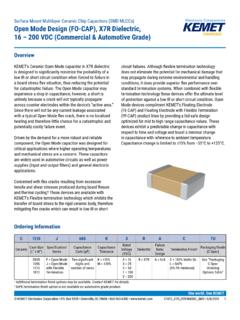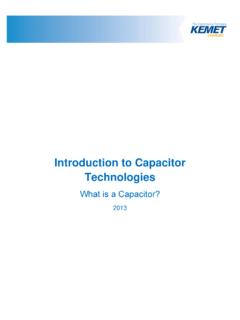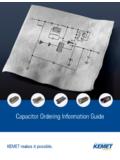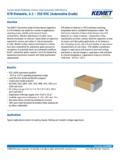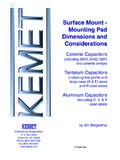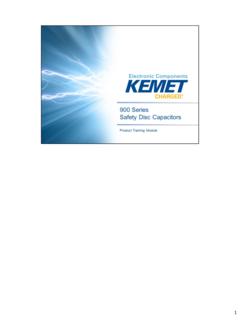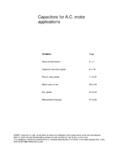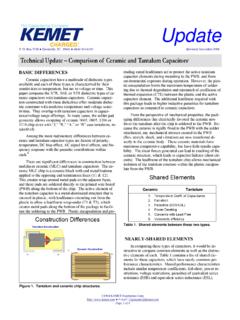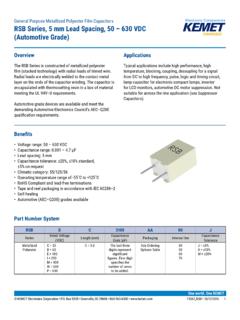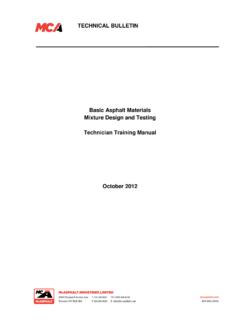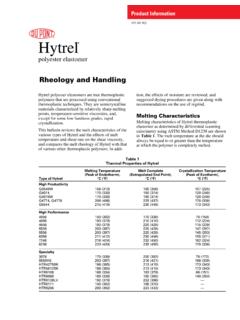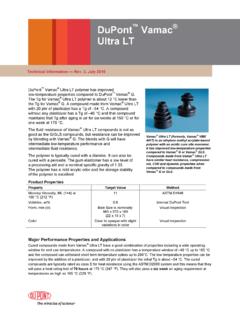Transcription of Reflow Soldering Process Considerations for …
1 Reflow Soldering Process Considerations for Surface Mount Applicationby Jim BergenthalF-2102A 7/95 Reprinted 10/97 Electronics Corporation P. O. Box 5928 Greenville, SC 29606 Phone (864) 963-6300 Fax (864) INTRODUCTIONR eflow Soldering , like wave Soldering , is not anew manufacturing Process . The hybrid industry hasused and refined the art of Reflow Soldering for manyyears. However, with the advent of Surface MountTechnology (SMT), Reflow Soldering has expanded inthe number of types and has been studied, refinedand explored as never different opinions have been expressedabout the best Process . We have found that the bestor optimum Process is the solder Process whichresulted in meeting the goals of Reflow Soldering forthe SMT application.
2 You can select the optimumsolder Reflow Process for your application if you: Understand the goals. Understand the Process and modify theprocess to meet the goals. Realize the best results are obtained fromthe Process which treats your product goals for Reflow Soldering are of two basictypes. The first is more traditional and includes: Uniform solder joints. Minimum repairs and part replacements. Minimum solder skips, solder balls and partmovements (tombstoning, etc.). Maximum cleanliness of the completedassembly. Maximum flexibility to allow Soldering a largenumber of circuits with minimum second type of goal is not normally thoughtof by Process engineering when first establishing thereflow solder Process .
3 These goals include: Minimum time above the liquidous soldertemperature to reduce solder grain growth,resulting in a more durable solder joint. Minimum stress and damage to the PrintedCircuit Board (PCB). Minimum damage and stress to the SMT parts. Minimum leaching of part terminationmaterials. Optimum conditions to minimize movement ofparts (all the neat names of tombstoning,drawbridging, etc.).These goals are in line with increasing productquality and achieve these goals, it is important to under-stand the Process , to modify it to meet our goals andto insure the product is protected. There are manytechnical and commercial descriptions of the reflowprocess already in print. Our look at the Process willbe a little different as we look at each phase, explainwhat it is attempting to achieve, show concern forimportant items, and point out some do s anddon ts.
4 Each of the specific processes will be re-viewed for its positives and what the critics aresaying about it. Methods of improving on the pro-cess, to balance these criticisms, are also aspect of treating the product with care will beinterwoven in the discussion and further discussedfor some specific us look into the Process SOLDER Process DESCRIPTIONThe basic Reflow solder Process consists of: Application of a solder paste to the desiredpads on a printed circuit board (PCB). Placement of the parts in the paste. Applying heat to the assembly which causesthe solder in the paste to melt ( Reflow ), wet tothe PCB and the part termination resulting inthe desired solder fillet Solder PasteThe solder paste mixes are improving as thedemands of Reflow Soldering for SMT and specification of the optimum pasteis a key item in the Reflow solder Placement of the parts in the paste is not difficultif the pad design considers all the applicabletolerances.
5 (See KEMET Application Bulletin Surface Mount - Mounting Pad Dimensions andConsiderations ). Care should be taken duringthe transportation of the PCB s not to smear thesolder paste or move parts. Inspection ofplacement accuracies and subsequent manualmovement of parts in wet paste has been shownto increase repair rates after Application of heat to result in the eventualsolder joint must consist of the following discreteitems:- Preheat cycle is intended to drive off most ofthe volatile solvents contained in the pastebefore the flux begins to work. This assists ininitiating fluxing action on the solder powderand the metal surfaces to be Additional preheat time to elevate thetemperature of the PCB, solder paste, andterminations to a temperature near the meltingpoint of the Additional heat transfer to elevate thetemperature over the liquidous point of Temperatures to be achieved are the liquidousmelting point of solder.
6 Liquidous points for -60 Sn/40 Pb solder is ..188 C63 Sn/37 Pb solder is ..183 C62 Sn/36 Pb/2 Ag solder is 179 CAdditional heat is required to insure activationof the rosins. However, heat should be limitedto minimize the times some parts are abovecritical Assisted temperature cooldown to the soldersolidification temperature, followed by gradual(static) cooling to temperature near insure good Reflow solder results, the follow-ing items should be considered. The temperatureprofile and equipment choices are only part of theequation for Circuit BoardsBake boards at elevated temperatures priorto application of solder paste. This eliminatesexcessive moisture from the board. Moisture inthe board, under solder resist layers, trappedwithin layers, etc.
7 , can lead to excessive solderdefects. A time of 4 hours minimum at 65 C isgenerally adequate. Baking should be donewithin 8 hours of assemblies, which are to be double sidereflow soldered, should not be cleanedafter the first side solder. This could induce adetrimental level of moisture, which willincrease the defects when the second side isreflow boards are usually of two basictypes. Bare copper pads (with a protectivesealer to prevent oxidation) have been usedsuccessfully in many applications. When barecopper pads are used, care must be taken inthe Process and repair sequence. The protectivesealer is designed to be easily washed off bynormal cleaning and fluxing agents. Normalcorrection of errors, such as washing wetadhesive off a board which has beenincorrectly processed, cleaning solder pastefrom a board which has exceeded the tack timeof the paste, etc.
8 , cannot be done withoutremoving the protective sealers and exposingthe copper to oxidation. Adhesive cure tem-peratures may also have to be limited toprotect the sealer. These sealers fortunatelyrespond to over-temperature by changingcolor. The second type is the PCB with soldercoated pads. These boards are usually fused orreflowed to increase the coverage of the solderto the edge faces of the copper and to preventfurther chemical processes in the boardmanufacture fromdamaging the solderabilityby attacking the copper through the porous tinplate. This Reflow can result in dome shapedpads to mount parts on. Hot air leveling isusually specified to minimize this feature. Ifyou are going to use a No-Clean Process , itmay be important to specify the cleanliness ofthe PCB.
9 Individual wrapping of the boardwill help keep it clean before pad designs and considerationsare critical. Review of other standards (such asIPC, EIA, and KEMET s recommendations) arean excellent place to start. However, the bestpad is the pad optimized for your set ofconditions. Trial and retrial is keep all pads, traces and partsaway from the board edges. The amount willbe determined by your board transportationmethods, magazines, carriers, etc. Also, leaveroom between parts for visual inspection andfor rework. Keep through hole vias out fromunder parts. Solder build up on the via, alongwith subsequent Reflow during the solderingprocess, will tend to move the part at thiscritical time. Tenting the via with solder maskdoes not help this tolerance of PCB tooling holes toartwork is recommended.
10 These will deter-mine location of solder paste and componentsto the designed pads. Optical location duringPCB manufacture is Paste:Selection of a good solder paste is impor-tant. This is a subject unto itself. We suggestyou work closely with your supplier andinform him of your Process and profiles. Pasteshave been developed which optimize thesolder Process , however, these have beendeveloped for a specific set of profiles, and arenot always applicable to your Process . Sometrial and inspection, and retrial, is paste you select should be in-spected on a routine basis, and consistencyfrom lot to lot is an important important variables are viscosity andslump tests. Understanding the effect ofpremixing and test temperature on viscosity isimportant to your incoming inspection pro-gram.
